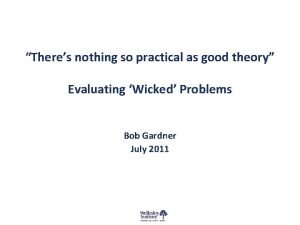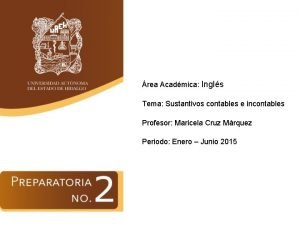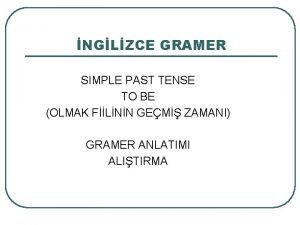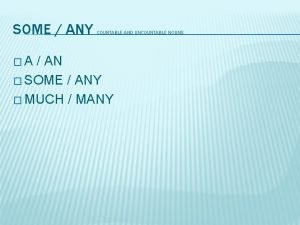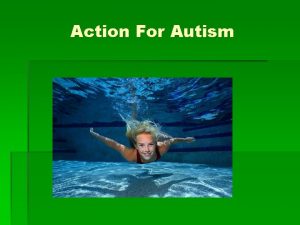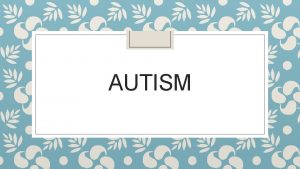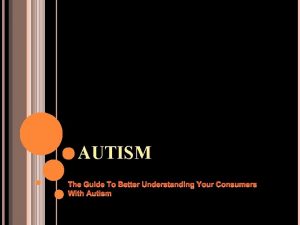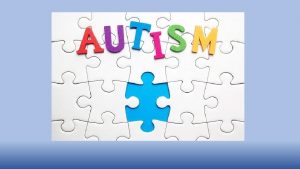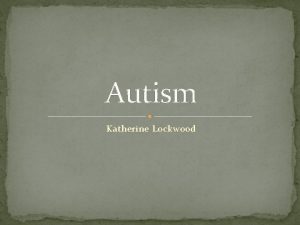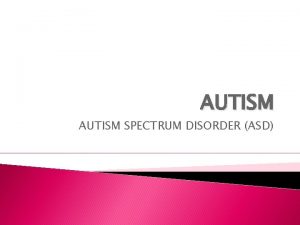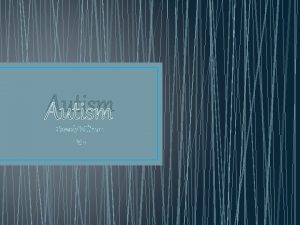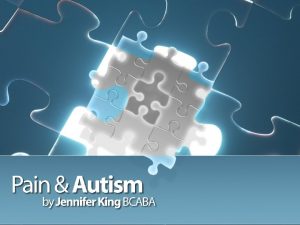Autism Overview What is Autism Is there more




























- Slides: 28


Autism

Overview What is Autism? Is there more than one type of Autism? How is Autism diagnosed? What are the characteristics of Autism?

WHAT IS AUTISM? Very complex, often baffling developmental disability First described by Leo Kanner in 1943 as early infantile autism “Auto” – children are “locked within themselves” For next 30 years, considered to be an emotional disturbance

WHAT IS AUTISM? Today, autism is a severe form of a broader group of disorders These are referred to as pervasive developmental disorders Autism typically appears during the first 3 years of life

WHAT IS AUTISM? Very likely neurological in origin Prevalence figures vary widely, recent data suggests as high as 1/150 births s (Centers for Disease Control Prevention, 2007) 4 times more prevalent in boys No known racial, ethnic, or social boundaries No relation to family income or lifestyle

WHAT IS AUTISM? Autism impacts normal development of the brain in areas of social interaction and communication skills. Individuals with autism find it difficult to communicate with others and relate to the outside world. Occasionally, aggressive and/or self-injurious behavior may be present.

WHAT IS AUTISM? Repeated body movements (hand flapping, rocking) Unusual responses to people Attachment to objects Resistance to change in routine Sensory sensitivities

WHAT ARE THE TYPES? Actually, the “umbrella” heading is Pervasive Developmental Disorder (PDD). Autism is one of the 5 PDDs. They all have commonalities in communication and social deficits. They differ in terms of severity.

1. Autistic Disorder Impairments in social interaction, communication, and imaginative play. Apparent before age 3

2. Asperger’s Disorder Impairments in social interactions, and presence of restricted interests and activities No clinically significant general delay in language Average to above average intelligence

3. Pervasive Developmental Disorder – Not Otherwise Specified (PDD-NOS) Often referred to as atypical autism Used when a child does not meet the criteria for a specific diagnosis, but there is severe and pervasive impairment in specified behaviors

4. Rett Syndrome Progressive disorder which typically occurs in girls Period of normal development and then the loss of previously acquired skills Also loss of purposeful use of hands, which is replaced by repetitive hand movements Beginning at age of 1 -4 years

5. Childhood Disintegrative Disorder Normal development for at least the first 2 years Then significant loss of previously acquired skills

Conclusions on Types Autism is a spectrum disorder This means that symptoms and characteristics can present themselves in wide variety of combinations, from mild to severe Autistic individuals can be very different from each other “Autism” is still commonly used to refer to any of the 5 PDDs

How is Autism Diagnosed? No definitive medical test Team uses interviews, observation, and specific checklists developed for this purpose Team might include neurologist, psychologist, developmental pediatrician, speech/language therapist, learning consultant, etc. Must rule out MR, hearing impairment, behavior disorders, or eccentric habits

CHARACTERISTICS 1. 2. 3. 4. 5. 6. Communication/Language Social Interaction Behaviors Sensory and movement disorders Resistance to change (predictability) Intellectual functioning

1. Communication/language Broad range of abilities, from no verbal communication to quite complex skills Two common impairments: A. Delayed language B. Echolalia

A. Delayed language Pronoun reversal: “You want white icing on chocolate cake. ” Difficulty in conversing easily with others Difficulty in shifting topics Looking away; poor eye contact

B. Echolalia Repeating words or phrases made by another person Common in very young children (Age 3) Immediate repetition or delayed repetition (even years later) May or may not be communicative

2. Social Interaction One of hallmarks of autism is lack of social interaction 1. Impaired use of nonverbal behavior 2. Lack of peer relationships 3. Failure to spontaneously share enjoyment, interests, etc. with others 4. Lack of reciprocity (all one-sided, no give and take)

3. Behaviors Repetitive behaviors, including obsessions, tics, and perseveration ( (repeating a response at a later time when not appropriate) Impeding behaviors (impede their learning or the learning of others) Will need positive behavior supports A. Self-injurious behavior B. Aggression

4. Sensory and movement disorders Very common Over- or under-sensitive to sensory stimuli Abnormal posture and movements of the face, head, trunk, and limbs Abnormal eye movements Repeated gestures and mannerisms Movement disorders can be detected very early – perhaps at birth

5. Predictability Change in routine is very stressful May insist on particular furniture arrangement, food at meals, TV shows Symmetry is often important Interventions need to focus on preparing students for change if possible

6. Intellectual functioning Autism occurs in children of all levels of intelligence, from those who are gifted to those who have mental retardation In general, majority of individuals with autism are also identified as having mental retardation – 75% have below 70 IQ Verbal and reasoning skills are difficult

Interventions Include life skills, functional academics, and vocational preparation Positive behavior support Social stories Individualization and early intervention are the keys!!

American Academy of Pediatrics Recommendations All children should be screened for autism by their family pediatrician twice by the age of 2, at 18 months and again at 24 months. Treatment should be started when an autism diagnosis is suspected rather than waiting for a formal diagnosis.

Resources Autism Society of America Center for Disabilities: Autism Spectrum Disorders Program http: //health. pppst. com/autism. html
 Lirik lagu more more more we praise you
Lirik lagu more more more we praise you More more more i want more more more more we praise you
More more more i want more more more more we praise you What is autism
What is autism Aspire not to have more but to be more
Aspire not to have more but to be more More choices more chances
More choices more chances Newton's 1 law
Newton's 1 law Human history becomes more and more a race
Human history becomes more and more a race The more you take the more you leave behind
The more you take the more you leave behind Knowing more remembering more
Knowing more remembering more The more you study the more you learn
The more you study the more you learn The more i give to thee the more i have
The more i give to thee the more i have Ive tasted and seen of the sweetest of loves
Ive tasted and seen of the sweetest of loves Nothing so practical as a good theory
Nothing so practical as a good theory Beneath this mask there is more than flesh
Beneath this mask there is more than flesh When there is no more room in hell
When there is no more room in hell Cheese contable o incontable
Cheese contable o incontable There is there are negative form
There is there are negative form There is there are
There is there are Ecological succession
Ecological succession The tweezers in this drawer
The tweezers in this drawer There is and there
There is and there There is ve there are
There is ve there are Hayis
Hayis Adjetivos demonstrativos
Adjetivos demonstrativos There is there are ejemplos
There is there are ejemplos There was there were ile ilgili cümleler
There was there were ile ilgili cümleler There is some cake
There is some cake Any some правило
Any some правило There is there are part of speech
There is there are part of speech












